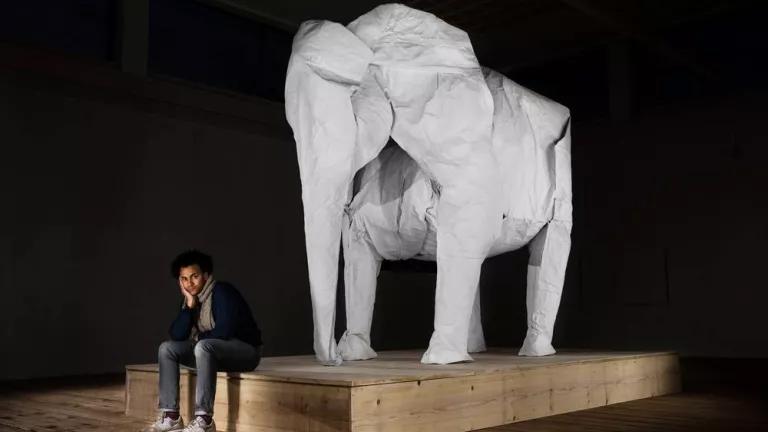This Origami Elephant Is as Fragile as the Real Ones
At this month’s Expo Chicago, one artist has paper convey how the animal’s future is unfolding.

Artist Sipho Mabona with his origami elephant
So, how exactly do you sculpt a giant elephant out of a single sheet of paper? It takes time, patience, and a whole lot of artistry—three things Swiss artist Sipho Mabona has in spades.
He’s been turning paper into art for 20 years, and no challenge seems too big for him to tackle―er, fold. Two years ago in Beromunster, Switzerland, 150 miles from Geneva, where the artist is based, he created his first origami elephant for the KKLB museum. The work, supported by a wire frame, took a month to complete and came out weighing 550 pounds. Soon Mabona will be sending another origami elephant stateside to the Expo Chicago art fair, which runs from September 22 to 25, in hopes that the event’s 45,000 visitors will get a dose of conservation with their art.
Mabona’s latest pachyderm was created from a 25- by 25-foot sheet of white paper, a material representative of the animal’s plight. “Using paper as a medium shows how fragile the elephants actually are,” he says. “They look powerful, but at the same time, it’s easy for us to extinguish them, which we are pretty close to doing.”
A recent African elephant census showed that the population declined 30 percent from 2007 to 2014, with numbers continuing to shrink by 8 percent each year. African forest elephants are in even greater trouble, with some scientists predicting the species could go extinct within the decade. Poachers kill tens of thousands of the animals every year for their tusks.
“At this point, more elephants are being poached than are being born, which is a huge problem,” says Elly Pepper, a wildlife advocate for NRDC. The sculpture is part of an exhibit commissioned by NRDC to bring attention to the world’s struggling wildlife.
At four feet tall, the elephant calf at the fifth annual Expo Chicago is smaller than Mabona’s previous work, but it still makes a sizable impression. It took three people (Mabona and two assistants) a week to make it, carefully wetting and folding the paper and letting it stiffen in place. But perhaps the coolest part of the project is that it was done without any plans for when and where to fold. Mabona doesn’t need outlined steps like those in origami packets for kids; the sequence of hundreds of folds are all in his head.
Smaller elephants and rhinos, another gravely endangered species, will accompany the calf to the art fair. These works are flat pieces of paper but have all the creases needed to become 3D sculptures. They’re meant to show the potential of something that’s about to happen rather than something being undone, says Mabona.
This year’s Expo comes on the heels of two international conservation meetings. At the International Union for the Conservation of Nature’s World Conservation Congress held in Hawaii at the beginning of the month, delegates passed a global, voluntary ban on domestic ivory sales. And next week, government officials will come together in South Africa for the Convention on International Trade in Endangered Species meeting, where they could pass a similar measure.
“I felt like folding a life-size elephant from a single sheet of paper would defy the limitations of what people would think is possible in origami,” Mabona says. But it’s more than that. “It’s a general symbol for defying limitations.”
Getting interest groups and governments to work together is critical to saving African elephants, Pepper says. Just as in Mabona’s origami, an elegant solution to save the species will take problem solving, patience, and a bit of artistry.
This article was originally published on onEarth, which is no longer in publication. onEarth was founded in 1979 as the Amicus Journal, an independent magazine of thought and opinion on the environment. All opinions expressed are those of the authors and do not necessarily reflect the policies or positions of NRDC. This article is available for online republication by news media outlets or nonprofits under these conditions: The writer(s) must be credited with a byline; you must note prominently that the article was originally published by NRDC.org and link to the original; the article cannot be edited (beyond simple things such grammar); you can’t resell the article in any form or grant republishing rights to other outlets; you can’t republish our material wholesale or automatically—you need to select articles individually; you can’t republish the photos or graphics on our site without specific permission; you should drop us a note to let us know when you’ve used one of our articles.

The Long, Long Battle for the Arctic National Wildlife Refuge
How to Become a Community Scientist
These 5 Animals Would Be Goners Without the Endangered Species Act